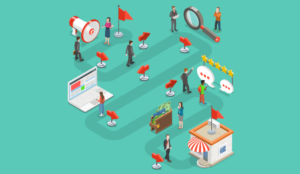Martina Ivanovic at Infobip explains how customer experience is centred around more than good service. Find out how to boost your entire customer journey with the right technology – and try out these use case examples.
Welcome to the era of the Customer. With an abundance of brands to choose from, an endless number of industries to explore, and a seemingly never-ending list of ways to connect – customers today have the power to design the buying experiences they want.
Because of this, brands have started to shift their focus from the four Ps of marketing (product, price, place, and promotion) to the Fifth P – People.
Don’t have a friction-free checkout process? Didn’t send your loyalty members their birthday greetings? Haven’t sent out your new loan offer notifications yet?
You can Risk Losing Business and Building a bad Reputation.
Today’s fierce competition and race to grab customers’ attention and keep them loyal to a brand has changed the B2C landscape, forever.
In this blog, we explore:
- What a great customer experience really is and why it matters
- How you can provide a great customer experience with the right technology
- Use cases, examples, and tools to help you start your own CX transformation
What is Customer Experience and Why Does it Matter
Customer experience is how a customer perceives your brand based on the interactions they’ve had. It can be a good or bad experience – and these interactions can be with your customer service agents, app, website, processes and policies, and more.
When a customer has a Good Experience, they’re more likely to spread positive word-of-mouth to their family and friends. And, since word-of-mouth is directly responsible for 90% of all purchases – this can only work in your favor.
On the contrary, bad Experiences can lead to negative word-of-mouth. In fact, the average customer who has a bad experience tells up to 16 people about it. And those who have a second bad experience with a business will tell Over 20 People. In other words, bad experiences lead to unfavorable outcomes.
In essence, delivering a great customer experience should be a priority for your business if you’re looking to Build Loyalty, Reduce Costs, and Drive Sales.
So, what makes a customer experience Great?
There are many moving parts, but the areas that have become a priority today include:
- Equipping your agents with the right tools to provide fast, personalized service
- Eliminating friction during checkout and other processes where your customers’ end goal is to complete a purchase, form, or similar as soon as possible
- Enabling self-service capabilities so customers can get answers, fast
- Tailoring the experience to customer preferences, such as communicating on their preferred channels
How to Provide a Great Customer Experience
We recently highlighted ways you can future-proof your tech stack with a conversational customer experience. Here are a few more ways you can streamline each stage of the customer journey with the right tools and technology.
Identify Key Touchpoints
The first step is to map out Your Customers’ Journey. Although the journey is not linear, and every customer is unique, it’s important that you identify the key Touchpoints customers have with your brand – and you work to improve those first. At the end of the day, the goal is to build a connected customer experience across the entire journey.
For Example, if you’re a bank and you know that customers interact with your representatives the most when being onboarded, it’s key to automate as many parts of the onboarding process as possible while keeping it engaging. One way would be to incorporate Onboarding Videos that you can send to clients on WhatsApp – and follow up with a list of tailor-made offers.
Equip Your Agents
Your customer support agents are an integral part of your customer experience. Their level of Fast, Personalized, and Accurate Support dictates your customers’ level of satisfaction and repeat business.
Equipping your agents with the right tools to provide a great level of service is key. Being able to access customer profiles, conversation history, context cards, and other details in a few clicks can be what takes your customer experience from good to great.
Consider This Scenario:
One of your agents has a handful of customers waiting on hold. They’ve managed to get in touch with one while helping the other to let them know they’ll be assisted shortly.
When the agent is done with the current customer, the second customer stops responding to the initial Live Chat messages. Now, the agent could eliminate the customer from the queue altogether, or, with a cloud contact centre, they can Message the Customer on Another Channel without losing the conversation history – and without exiting the current window.
This way, the customer still receives the assistance they needed, and the agent doesn’t have to waste time switching tabs, opening new channels, and cross-referencing conversations that took place on other channels.
Eliminate Friction and Enable Self-Service
There is probably nothing worse than waiting to make a payment or sign up for a service, only to be greeted with a ˝check your email˝ pop up.
Friction can be painful, especially for customers who want to complete their purchases or processes fast and on-the-go. If not met with quick, alternative solutions, these customers often have no problem taking their business elsewhere.
The easiest way to eliminate friction is to introduce self-service options, such as keyword or AI chatbots.
Set up a chatbot to:
- answer frequently asked questions
- share relevant information
- process personal details on secure channels, such as WhatsApp
Your chatbot can collect documents to complete policy renewals, activate credit cards, open new bank accounts, or similar. They can also process purchase details, streamline returns and refunds, and share new offer details.
Another way to eliminate friction is to introduce silent mobile authentication, otherwise known as Mobile Identity. This is one of the most secure ways to streamline the entire purchase journey. Complete in less than 5 seconds and with only two steps, mobile identity eliminates interruptive user experiences, security concerns, and cart abandonment.
Tailor Interactions to Customer Preferences
The most important part of the customer experience is the Customer.
Knowing and understanding your customers’ preferences will help you tailor the experience to their needs. As we mentioned before, no journey is the same and no two customers are the same. So, having a one-size-fits-all experience can hurt your business.
The easiest way to get to know your customers’ preferences is to ask them. Add Check box Options on Your Sign-up Form asking them what channel(s) they prefer to be contacted on – and see if they’ll opt-in for special offer notifications or similar. Another great way to gather information is through post-purchase or post-service feedback surveys.
The more information you gather from your customers, the better you’ll know them, and the closer you’ll be to Offering a Unique Experience specific to their needs.
What’s equally important is how you store and use this data. Having a platform that connects insights from all your touchpoints to create a 360° view of your customer is key to providing great customer experiences.
Connecting this to a customer engagement hub and cloud contact centre equips all your employees with the information they need to get the job done.
Use Cases and Examples
Here are a few use cases and examples to help you get started with your own customer experience transformation – from onboarding to retention.
- Engage With and Onboard new Customers: Welcome your new customers by sending them a message to announce enticing new products that are in store for them on their preferred channel.
- Activate an Account or Service Using Chatbots: Enable customers to activate or sign up for different services directly through chat channels including WhatsApp, Messenger, and more.
- Quickly Respond to Customer Order Inquiries: Set up interactive voice response (IVR) to give customers the most up to date status about their order when they call in while reducing hold times.
- Gather After-purchase Feedback: Set up an event trigger after customers make a purchase to send them a product or service survey to fill out. Gather reviews and improve your services or processes if and where you need to.
- Automate Your Customer Loyalty Program: Set up automated messaging on your customers’ preferred channels to send out birthday coupons, special promos, welcome messages, and more.
Give Your Customer Experience a Boost
Streamlining communication and processes with the right tools and technology can make revamping your customers’ experience a breeze. That’s why we’ve built Customizable Solutions to help you meet customers where they are and experience the ROI you’ve been waiting for.
Explore our cloud solutions and discover an easier way to make your customer experience great again:
- Conversations: Give your agents and managers everything they need to provide superior customer service with a Cloud contact centre. Combine conversation history, customer data profiles, and context cards with any channel you prefer in a single workspace. Your agents can continue the conversation anywhere at any time and can provide service on the go with the Conversations Mobile App.
- Answers: Build your own keyword or AI chatbot without a line of code. Use our Drag-and-drop Chatbot Building Platform to automate answers to frequently asked questions and empower customers to move along their journey on their own. Offload simple queries from your agents and provide fast, personalized support in just a few clicks.
- Moments: Engage customers with Behavior- and Event-triggered Messaging. Follow them along their journey to provide all the information they need to complete purchases, sign-ups, and other unique goals that build long-term relationships.
Author: Guest Author
Published On: 15th Oct 2021
Read more about - Guest Blogs, Infobip















